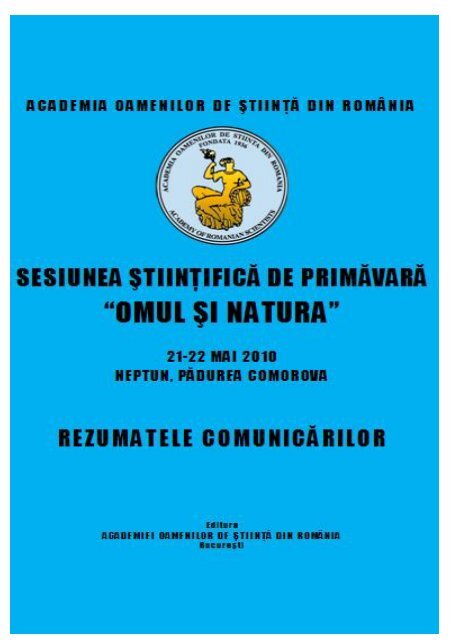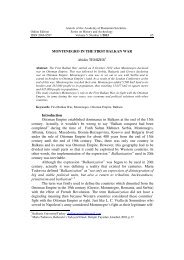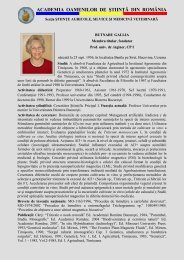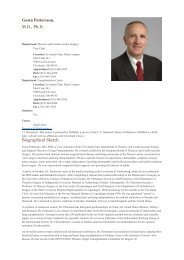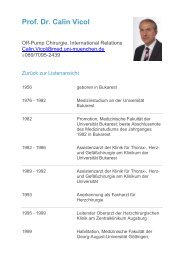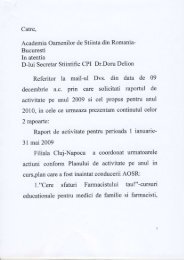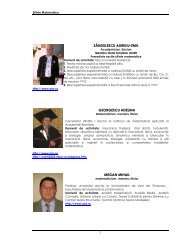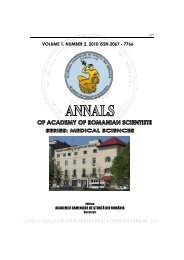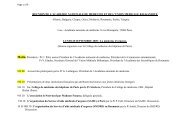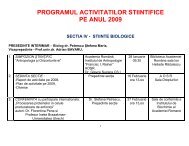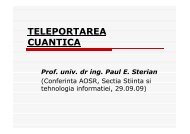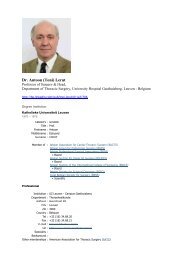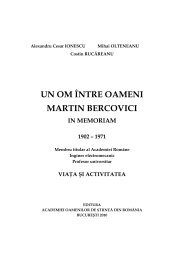sesiunea ÅtiinÅ£ificÄ de primÄvarÄ âomul Åi naturaâ 21-22 mai 2010 ...
sesiunea ÅtiinÅ£ificÄ de primÄvarÄ âomul Åi naturaâ 21-22 mai 2010 ...
sesiunea ÅtiinÅ£ificÄ de primÄvarÄ âomul Åi naturaâ 21-22 mai 2010 ...
- No tags were found...
You also want an ePaper? Increase the reach of your titles
YUMPU automatically turns print PDFs into web optimized ePapers that Google loves.
SECŢIUNEA III1 11.30 – 11.452 11.45 – 12.00VINERI <strong>21</strong> MAI <strong>2010</strong>LUCRĂRI 11,30 – 13.00Chairman: Petru ANDEAStudy on Heavy Metals fromEnvironmental Samples by AtomicTechniques.Medicinal Plants Offals Used in theDepoluttion of Waste Waters Infested byHard MetalsIon V. POPESCU,Cristiana RADULESCU,Claudia STIHI,Gabriela BUSUIOC,Anca Irina GHEBOIANU,Valerica Gh. CIMPOCANeculae ANTOHE,Carmen TEBRENCU,Ramona VERDES,Gabriela MITROI,Elena IONESCU3 12.00 - 12.15 Hydrogen – One of the Alternative Fuels Ştefan IANCU4 12.15 – 12.305 12.30 – 12.456 12. 45– 13.007 14.30 – 14.458 14.45 - 15.00Assessment of Soil Density and Moistureby Nuclear MethodsImpact of Energetical Engineering onHealth and EnvironmentSustainability Trends in Building withEco-Friendly Materials13.00 - 14.30 MASA DE PRÎNZLUCRĂRI 14,30 – 16.00Chairman: Ion CHIUŢĂAnalytical Evaluation of CrackPropagation for Bulb HydraulicTurbinesShaftsInfluence of Great Hydraulic Works uponNature and MankindDorel BUCURESCUIon CHIUŢĂ,Liviu Mihai SIMAIrina LUNGU,Anghel STANCIU,Nicolae BOŢIMircea O. POPOVICU,Ilare BORDEASU,LIVIU MARSAVINAMircea O. POPOVICU,Petru ANDEA,Georgeta NICHITA,OANA DULCA13
9 15.00 – 15.1510 15.15 – 15.3011 15.30 - 15.45Wood, Renewable Resource for GreenEnergyForest Species Used in PhytoremediationProcessThe Seismic Phenomenon in theCarpatho-Danubian-Pontic Region andTheir Consequences on the Behaviour ofInhabitants of These PartsIvan CISMARUGabriel CORNEANU,Constantin CRĂCIUN,Mihaela CORNEANU,Luminita COJOCARU,Cornelia HERNEADan Ion PREDOIU12 15.45 – 16.00 Disaters and the World Insurance Nicu-Bogdan POPA16.00 – 16.15 PAUZĂ DE CAFEALUCRĂRI 16,15 – 17.00Chairman: Ion V. POPESCU13 16.15 – 16.3014 16.30 – 16.4515 16,45 – 17.00Mathematical Methods for theOptimization of the Aeolian Energieswith Applications in Hydro-AerodynamicsEnvironmental Security - Component ofNational Security Foreshddowing ofEcologic Elements Content in theNational Security StrategyThe Influence of Geo-Climactic Factorson Military ActionsMircea LUPUConstantin MINCUNicolae CIOBANU16 17.00 - 17.15 Crisis Management in Shipping ArealŞtefan GeorgescuRăzvan Stoleru14
GLOBAL WARMING AND INTERNATIONAL SECURITYConstantin VLAD 11 Prof. Ph.D., Founding Member of Aca<strong>de</strong>my of Romanian ScientistsThere is a direct connection between un<strong>de</strong>r<strong>de</strong>velopment, international security andbelligerence. The statistics show that measures aimed at fighting against global warmingcontribute to <strong>mai</strong>ntain un<strong>de</strong>r<strong>de</strong>velopment, which represents a favorable ground forbelligerence. An the same time, the above mentioned measures could impe<strong>de</strong> the changeof international configuration of power relations and the access of some big <strong>de</strong>velopingcountries, like China, India and Brazil to a more visible role in the world affairs.STUDY REGARDING THE ACCLIMATIZATION AND BEHAVIOR OFCERTAIN VARIETIES OF ASIMINA TRILOBA (L.) DUNAL OF ROMANIAIon Nicolae 1 , Daniela Fănuţa Mihăilă 1 , Cristina Nedianu 3 , Razvan Cotianu 41 Prof., Ph.D., Presi<strong>de</strong>nt of Bioterra University from Bucharest, Founding Member ofAca<strong>de</strong>my of Romanian Scientists, nicolaebio@yahoo.com2 Lecturer Ph.D., Bioterra University from Bucharest, mihaila_md_daniela@yahoo.com3 Lecturer Ph.D., Bioterra University from Bucharest4 Lecturer Ph.D., Bioterra University from Bucharest, cotianu_razvan@yahoo.comIn the last 15 to 20 years, it seems that the species of Asimina triloba (L.) Dunal, knownas "North banana" is the subject of growing interest in many countries, including Europeand Romania. Asimina species, except A. parviflora (Michx.) Dunal and A. triloba, arelocated in the State of Florida and in some parts of extreme Southern Georgia andAlabama States (Callaway 1990). Asimina parviflora is spreading in the Southern UnitedStates, while Asimina triloba extends throughout the East, culminating in SouthernCanada. In Romania, there are many researches for acclimatization of this species,valuable in terms of food.FUEL CELL PROTON EXCHANGE MEMBRANE- PRESENT AND PERSPECTIVESVictor CIUPINA 1 , E<strong>de</strong>n MAMUT 2 , Iuliana Mihaela OANCEA-STĂNESCU 31 Prof., PhD, Senior Researcher, affiliation: Faculty of Physics and Chemistry, Ovidius Universityof Constanta, Romania, Member of Aca<strong>de</strong>my of Romanian Scientists, rectorat2@univ-ovidius.ro2 Prof., PhD, Senior Researcher, affiliation: Faculty of Mechanical Engineering, Ovidius Universityof Constanta, Romania, emamut@univ-ovidius.ro3 PhD stu<strong>de</strong>nt, Researcher Assistent, affiliation: Faculty of Physics and Chemistry, OvidiusUniversity of Constanta, Romania, istanescu@univ-ovidius.roFuel cells could contribute to the reduction of the polluting emissions of the fossil fuelsdue to the conversion efficiency which is higher than in the case of other energyconversion systems. There are many possibilities to improve the efficiency and to reducethe weight of the fuel cells by the integration of new nanostructured materials.15
TECHNOLOGICAL SYSTEM OF ECOLOGIC AGRICULTURE WITHVEGETAL SPECIES IN PURE OR ASSOCIATED CULTUREAurel LUP 1 , Nicolae ALEXE 11 Prof., PhD, Faculty Natural Sciences and Agriculture; Agricultural Chair. Institute:,,OVIDIUS” university of Constantza, Romania, lupaurel@yahoo.com2 Manager of agricultural Society ,,STEPA”, Constantza county, RomaniaThe paper <strong>de</strong>scribes an original system of ecologic agriculture in the driest area inRomania, i.e. the Northern plateau of Dobrogea. The soils are medium fertile, withoutirrigation. One grows cereals, pulses, oilseeds as pure culture or associated in rain fallagriculture. The seeds are exported and farm activity is profitable.PSYCHOLOGICAL DIMENSIONS OF THE RELATIONSHIPBETWEEN MAN AND NATUREMihai GOLU 11 PhD, Prof., Member of the of Aca<strong>de</strong>my of Romanian ScientistsThis paper points out some major aspects of the dynamics of the relationship betweenman and nature, <strong>de</strong>pending on the psychological <strong>de</strong>velopment and organisation of theformer. Two <strong>mai</strong>n stages are <strong>de</strong>limited: a) the passive-reacting stage and b) the activetransformingstage.Characteristic for the first stage is a diffuse consciousness, which sustains the perceptionand the feeling that man is intrinsically a constituent part of nature.The second stage is characterised by the process of differentiation and specialisationinsi<strong>de</strong> the consciousness, and by the <strong>de</strong>velopment of self-consciousness and ofindividualisation. This acquisition has led to the <strong>de</strong>velopment of man’s capacity tosystematically create and produce the tools by means of which man could act to change ortransform some given conditions of nature. Historically, this process, which has beenperfected, became the <strong>mai</strong>n psychological factor that influenced the character of therelationship between man and nature, in both positive and negative ways.EARTH – CRADDLE OF HUMANITYMarius BĂCESCU 11PhD, Professor, Member of Aca<strong>de</strong>my of Romanian Scientists, Romania, Presi<strong>de</strong>nt ofEconomics, lawyerlike and sociology SectionAfter the presentation of the report between the natural environment and the surroundingenvironment, it is emphasized the influenceof the human being on the terrestrialenvironment and especially on soil erosion and pollution. At the same time, this studypoints out the natural disasters over the environment and the influence of atmosphere overthe earth health, after which it is mentioned what should be done in or<strong>de</strong>r to assure ahealthy shelter for the humanity.16
SUSTAINABLE DEVELOPMENT IN THE CONTEXTOF THE RELATIONSHIP „MAN – NATURE”Ion I. BASGAN 1 , Gabriel I. NĂSTASE <strong>21</strong> Eng, PhD, Vice Presi<strong>de</strong>nt of the Aca<strong>de</strong>my of Romanian Scientists, Romania2 PhD, Associate prof. „Dimitrie Cantemir” Christian University, Faculty of Finance,Banking and Accounting Head of „FINANCE” Department, Correspon<strong>de</strong>nt Member of theAca<strong>de</strong>my of Romanian Scientists, RomaniaIn the long run, the environmental protection actions will have to correlate with thecountry’s social-economic <strong>de</strong>velopment actions and the concept of durable <strong>de</strong>velopmentof the economy, resource exploitation and quality of the environment will have to betaken into account. It is common knowledge that the intensity of the pollutionphenomenon is a result of the economic structure, especially of the industry, of theexisting legal framework and of the level of ecologic education of the citizens in thecountryA POSSIBLE DIVISION FROM THE PREFIX „POST-”: TRANS-NATUREViorella MANOLACHE 11 Ph.D., Institutul <strong>de</strong> Stiinte Politice si Relatii Internationale al Aca<strong>de</strong>miei RomâneThe term post-, even when (a) glued to any of the <strong>de</strong>rivations of notion of modo, re<strong>mai</strong>ns(multi)faced, mosaic-like, overturn in/by (self) reflexive reflections and irrigations. Theconfusion brought along by such suffixes (over) bid the multiple micro-narrations that donot propose any sort of universalizing stabilization or legitimacy. The alternative currentsof postmo<strong>de</strong>rnity will presuppose an abandonment of the evolutionist perspective and theacceptance of the paradigmatic revolution. Sinusoidal, the currents will gain being only asprotest movements against dominant theories or theoretical ten<strong>de</strong>ncies, and even more asdifferent paradigms, as the (re)configuration of the axiological relief in a space of a-value.A concept such as Homo sui transcen<strong>de</strong>ntalis reinvents the alternative character (asEpimetheus, Prometheus’s brother), as a character who bears the seal of trans- (transfigurative,trans-vision, trans-portation, trans- formation), the one who thinks after. In thisequation, trans- nature is the concept <strong>de</strong>signed to unify (into a philosophy of nature), theSubject and the cross-disciplinary Object, as a mark of the trans-disciplinary ecology.MAN RESPONSIBLEPetru ANDEA 1 , Oana DULCA 2 , Ioana MÎNZU 31 Prof. PhD. Eng., "Politehnica" University of Timisoara, Member of Aca<strong>de</strong>my of RomanianScientists, Presi<strong>de</strong>nt of Timişoara Branch, Romania, petru_an<strong>de</strong>a@yahoo.com2 PhD. Eng., Aca<strong>de</strong>my of Romanian Scientists, Romania, oana.pop@g<strong>mai</strong>l.com3 Drd., parliamentary expert, Committee for Education, Science, Youth, and Sport,Chamber of Deputies, Bucharest, ioana_minzu@yahoo.comThe paper examines ways that are obtained, in higher education, professional17
competences as they are set in the European Qualification Framework and <strong>de</strong>scribedthrough "Dublin <strong>de</strong>scriptors", which examines creating and introducing ways in Romaniaof a national qualifications framework of Higher Education of the National QualificationsRegister for Higher Education. The paper can serve for elaboration of normative actsnecessary to implement the National Qualifications Framework in Higher Education (CNCIS)and the National Qualifications Register for Higher Education (RNCIS).ECOSOPHIA – POLITICAL AND PHILOSOPHICAL ASPECTSHenrieta Anişoara ŞERBAN 11 PhD, Institut of Philosophy and Psychology C. Rădulescu-MotruThe study relates the term „ecosophia”, or ecological wisdom, to ecology and politicalphilosophy and observes the consequences or such correlations. This wisdom is assessedin its philosophical and political aspects, since it sustains an i<strong>de</strong>ology of either mo<strong>de</strong>rateor radical change. The ethics inspired by ecosophia is not mere i<strong>de</strong>alism or „eutopia”, buta chance for a prolonged existence for humanity, and, at the same time, a chance forhumanity to show its true and higly qualitatively „humane” meaning. As more or lessradical as it may be, ecosophia has to mediate and ammend technological progress, withwisdom.NATURE AS EXPERIENCED - A THEOLOGICAL PHENOMENOLOGYCristina GELAN 11 PhD, Assistent Professor „Andrei Şaguna” UniversityThe first stage of becoming human beings as a species on Earth is a direct reference to theexistence, to the concrete forms of the surrounding reality, which become objects to thispractice and also of consciousness. Once with the reporting human nature, the thoughtbegins his own religious experience. At this level, man proposes between him and theworld of nature of another world, mediator, through which to act on its possibilities ofexistence. Religious thought in consciousness becames a reflection of reality and aprojection of thought into reality. As a medium, it is an invention by not being in theobjective existence, but with excellent exercise as mediator in ontological form, in that healways took refuge in a concrete object.NORMAL AND PATHOLOGICAL. INTERDISCIPLINARY ASPECTSGeorge CONSTANDACHE 11 PhD, Professor at Polytechnica University, Bucharest.Les responsables <strong>de</strong> la recherche <strong>de</strong> notre pays comprirent, bien qu’un peu tard,l’importance <strong>de</strong> ce programme <strong>de</strong> recherches interdisciplinaires qui bousculait lesfrontières établies <strong>de</strong> longue date, amenant au dialogue et à la confrontation les18
neurophysiologistes et les psychologues, les philosophes et les ingénieurs, lesanthropologues et les linguistes.A CRITICAL REGARDING ARGUMENTAL STRATEGIESIN CREATIVE AND EVOLUTIONIST BIOLOGYMarius Augustin DRĂGHICI 1 , Oana VASILESCU <strong>21</strong>Ph.D, Senior Researcher, Institut of Philosophy and Psychology C. Rădulescu-Motru,mariusdraghiciinstitut@yahoo.com2Ph.D, Associate Researcher, Institut of Philosophy and Psychology C. Rădulescu-Motru,oanavasilescu78@yahoo.comIn this study, we investigated the epistemological presuppositions both of evolutionarybiology and of creationism from the perspective of the teleological argument implicit inthe concept of function (in the case of biology) and explicit (in the case of creationism).The hypothesis of the necessity of a philosophical-epistemological investigation is provedby means of employing comparative explanation following Kuhn’s mo<strong>de</strong>l of scientificrevolution in or<strong>de</strong>r to test the claims of scientific character of the biologist theory. Instead of confirming the claims about the “revolutionary scientific character” of DarwinianTheory and <strong>de</strong>nying the validity of Kuhn’s theory, we have found a systematic re<strong>de</strong>finingof concepts and epistemological claims within the mo<strong>de</strong>rn evolutionary biology. In turn,in the case of scientist creationism, by adopting and emphasizing the “strong” form of theAnthropic Principle conceived as scientific ground for the i<strong>de</strong>ology of mo<strong>de</strong>rncreationism, we found a theoretical-methodological ambiguity.ANTHROPIC REASONING IN CONTEMPORARY COSMOLOGYGabriel NAGÂŢ 11 Dr Ph.D, Senior Researcher, Institut of Philosophy and PsychologyC. Rădulescu-Motru, gabnagat@yahoo.comContemporary cosmology tries to explain the apparently "fine-tuning" of the universe byusing an "Anthropic Principle". According to this, we have to accept the i<strong>de</strong>a that ourlocation in the universe is necessarily privileged to the extent of being compatible withour existence as observers. This i<strong>de</strong>a seems to overrule the very spirit of the "Copernicanrevolution", which was the milestone of mo<strong>de</strong>rn science. The article examines somepossible methodological consequences of accepting the anthropic reasoning in today'sscience.DIVERSITY MANAGEMENTMartha-Christina SUCIU 11 Prof., PhD, Faculty of Economics, Economics and Economic Policies Department,Aca<strong>de</strong>my of Economic Studies, Bucharest, Romania, Correspon<strong>de</strong>nt member of Aca<strong>de</strong>myof Romanian Scientists, Romania, suciuchristina@yahoo.com19
Globalization amplified the multicultural issue. The author supports the i<strong>de</strong>a of theintercultural dialogue based on what can join people together according to common goals,with no prejudice on their right to be different and to manifest in a different way byexploring their talent and creativity. The paper presents briefly a part of the researchresults obtained within the scientific research project “PARTENERIATE 9<strong>21</strong>16”,research project that has been won by competition in 2008, the year that had been<strong>de</strong>clared at the European Union as “The Year of Intercultural Dialogue”. The topic of theresearch project is “Equality of chance-as a prerequisite of sustainable <strong>de</strong>velopment. Anevaluation system to promote diversity within the organizations from Romania”. Theauthor is the coordinator of the above mentioned research project.AETHETIC – A PSYCHOTROPIC FACTOR OF HEALTH GENESISViorica E. UNGUREANU 11Prof., PhD, Correspon<strong>de</strong>nt member of Aca<strong>de</strong>my of Romanian ScientistsHORIZONS AND CHANGES IN THE NEW SUSTAINABLE ECONOMYIon CUCUI 1 , Ion STEGAROIU 2 , Marius PETRESCU 3 ,Gabriela POPA 41 Prof. Ph.D. Valahia University from Târgoviște, Faculty of Economic Sciences,Member of Aca<strong>de</strong>my of Romanian Scientists, Presi<strong>de</strong>nt of Târgovişte Branch, Romania2 Prof.Ph.D. Valahia University from Târgoviște, Faculty of Economic Sciences3 Prof.PH.D. Valahia University from Târgoviște, Faculty of Economic Sciences4 Lect. Ph.D. Valahia University from Târgoviște, Faculty of Economic SciencesIt is said that the society we are moving towards is, or will be, the Informational Society -Knowledge Society (IS-KS). The collocation used to name the new society disclosesespecially the tools this one will stand on as well as their progress, which, at first sight,makes the impression of a technical, one-si<strong>de</strong>d name. The collocations used to name thesocieties so far contain a key-word (slave system, feudalism, capitalism) whichsynthesizes a gamut of possible social statuses where the people, individually and/or ingroup are inevitably situated on, function on certain circumstances, thus constituting acharacteristic economical-social structure. Obviously, the key-word able to disclose whatis or will be economically and socially fundamental for the new society has not been yetfound. IS-KS is a collocation which poses the name to some other fields.THE INVOLVEMENT OF BUCHAREST BIOTERRA UNIVERSITYIN THE DEVELOPMENT OF ECOTOURISM AND AGROTOURISMIN ROMANIAFloarea NICOLAE 1 , Mihai MARES 2 , Daniela MIHAILA 31Prof., Rector of Bioterra University from Bucharest, nicolaebio@yahoo.com2 Prof., Bioterra University from Bucharest, maresmihai@yahoo.com3 Lecturer Ph.D., Bioterra University from Bucharest, mihaila_md_daniela@yahoo.com20
Ecotourism is a mo<strong>de</strong>rn form of tourism with low environmental impact, based on itsassessment and make a conscious effort is to reinvest an appropriate share of revenue forconservation based on. By the way that natural values of an area as little altered to betransmitted to future generations, can be consi<strong>de</strong>red and sustainable tourism andawareness, appreciation and protection of nature caused by the actions of interest and theemergence of "green tourism", which suggests Are you still the tourist product shouldfollow and protect vegetation, animal life, their habitats, ecosystems and biodiversity.SYSTEM OF INDICATORS ON INTERNATIONAL COMPARABILITY OFHUMAN RESOURCES AND LABOUR RESOURCESAngelica BĂCESCU - CĂRBUNARU 11 Ph.D., Prof., Aca<strong>de</strong>my of Economic Studies, Bucharest, Correspon<strong>de</strong>nt member ofAca<strong>de</strong>my of Romanian Scientists, RomaniaAn essential factor of any country in economic and social <strong>de</strong>velopment is represented byavailable human resources (human potential), these resources being the whole populationof a respective country at a given moment. First of all, this potential should be regar<strong>de</strong>d as acollective consumer, being i<strong>de</strong>ntified with the total population, while as a collectiveproducer, it is i<strong>de</strong>ntified with labour resources, namely with number, experience and their<strong>de</strong>gree of trening.THE IMPACT OF MORALITY ON THE ENVIRONMENTDaniel FODOREAN 11PhD,Assistent Professor of Legal Ethics, Titu Maiorescu University,Street Dâmbovnicului, no.<strong>22</strong>, 040051 Bucharest, Romania,romanianamericaninstitute@g<strong>mai</strong>l.comThe objective of this paper is to highlight the part of man's moral responsibility towardsthe environment, but also to explore the relationship between personal morality and theenvironment, on the other hand. In the light of historical and theological perspective, theenvironmental situation is simply a reflection of personal and social morality at somepoint in history. Thus, it is not difficult to note that personal and universal moral pollutionhas led to a continuous environmental pollution and <strong>de</strong>gradation. Environmentalmeasures should not begin just with the environment itself, but with awareness,education, individual and collective transformation.AMERICAN DECLARATION OF THE RIGHTS AND DUTIES OF MAN. THEDIGNITY OF HUMAN BEINGConstantin JURCĂ 11 PhD, Associate Professor of Law, Ovidius University of Constanta, Ma<strong>mai</strong>a, Avenue No124, Constanta, 900527, romanianamericaninstitute@g<strong>mai</strong>l.com<strong>21</strong>
American Declaration of the Rights and Duties of Man, adopted at the ninth Conferenceof American States in Bogota in 1948, comes to highlight and prefaced treasure of i<strong>de</strong>asand principles of the Universal Declaration of Human Rights, approved by the UNGeneral Assembly. Our study is inten<strong>de</strong>d as a contribution to recognize the value of thesedocuments where the dignity and value of person are essential. This paper aims to reachthe constitutional legislator a number of positive elements, especially those concerninghuman dignity in all rights and duties of the individual. Other foundation can no man laythan that which human dignity has been ma<strong>de</strong>, based on moral behavior, the directexpression of spiritual cultural education principles and Christian values.A BETTER USE OF THE ROMANIAN NATURAL RESOURCESAIMING AT ENVIRONMENT PROTECTIONMariana Daniela MARICA 1 , Ion Nicolae 2 , Marian NICOLAE 3 ,Nicole Livia ATUDOSIEI 41 Bioterra University of Bucharest, maridaniela_2006@yahoo.com2 Prof., Ph.D., Presi<strong>de</strong>nt of Bioterra University from Bucharest, Founding Memberof Aca<strong>de</strong>my of Romanian Scientists, nicolaebio@yahoo.com3 Bioterra University of Bucharest, nicolae_marian@yahoo.com4 Bioterra University of Bucharest, nicole.atudosiei@rdslink.roIn Romania, the concept of “SUSTAINABLE DEVELOPMENT” was accepted,especially during the period of transition to market economy. This was possible becauseRomania adopted the international <strong>de</strong>velopment concepts, by elaborating the sustainablestrategies for managing its natural resources, with an emphasis on “the need to stop thenatural capital <strong>de</strong>gradation in the transition period and to preserve it in the perspective ofeconomic <strong>de</strong>velopment”. Natural resources, as forms of raw and energy materials, bothconventional and unconventional ones, both renewable and non-renewable, are the“natural capital”, an essential part of Romania’s wealth. The use of these resources can bema<strong>de</strong> better or worse, according to the technologies that can be used in the process and totheir availability. In this respect, “Recycling or reusing” materials and products, whosetechnological value was exhausted (metals, plastic, glass, old machines and equipment,etc.) and which normally cannot be absorbed and <strong>de</strong>gra<strong>de</strong>d in the natural ecosystems is agood example.GLOBAL WARMING AND TOURISMStan PETRESCU 11 Prof.Ph. D., Bioterra University, BucharestTourism is a very important activity: economical, social and holistic; it must contribute toincrease the satisfaction of those practicing it, organizing it, supporting it and it helps the<strong>de</strong>velopment of regions, investment interest, to be based on value, team-work andnetworking and be customer oriented, offering and <strong>de</strong>manding projects. It must not be<strong>22</strong>
igid and unimaginative, but it must be variated, because the diversification trend leads toevolution and improves relations between people.SOME CONSIDERATIONS ON FOOD SECURITY - A DECISIVEBASIC FACTOR OF THE QUALITY OF LIFEVladimir Alexandru ŢICOVSCHI 11 Ass, Prof. PhD. Eng., PhD. Economics, The Committee for the History and the Philosophyof Science and Technology of the Romanian Aca<strong>de</strong>myThe paper starts with the <strong>de</strong>finitions given to the concept of food security by the UnitedNations’ Food and Agriculture Organization ( FAO ) and the United States Department ofAgriculture (USDA , remarking the disillusioning fact that not only in the poor countriesbut also in the rich countries there are people who are living un<strong>de</strong>r the pressure of thefood insecurity. It is stressed on the increase of this crisis un<strong>de</strong>r the conditions of thefinancial-banking and economic global crisis and on the risks generated by unfavorableevents could threaten the food security worldwi<strong>de</strong>, the permanent filling of a lot of peoplebeing that the world is resting on a bomb with postponed explosion and with a timingcompletely unknown. Consi<strong>de</strong>ring that the globalization process will increase theintensive and extensive <strong>de</strong>velopment of the food security system to a hyper -large globalcybernetic system, the author suggests a three steps triadic thinking scheme, applicablealso to the analysis of the relation between the food security and the quality of life.NUMERICAL CODES TUNED ON THE PROBLEM. A WAYFOR ENHANCING THE EFFICIENCY OF SCIENTIFIC CODESLiviu Gr. IXARU 11 “Horia Hulubei” National Institute of Physics and Nuclear Engineering, Department ofTheoretical Physics, P.O. Box MG-6, Bucharest, Romania, ixaru@theory.nipne.ro, andCorrespon<strong>de</strong>nt member of Aca<strong>de</strong>my of Romanian Scientists, 54 Splaiul In<strong>de</strong>pen<strong>de</strong>nţei,050094, Bucharest, RomaniaAny advance of the knowledge to be reached nowadays in natural sciences (physics,chemistry, biology, technical disciplines etc.) cannot be imagined without the intensiveuse of the computer facilities. This implies the <strong>de</strong>velopment of more and more complexnumerical co<strong>de</strong>s, on the one hand, and the use of bigger and bigger computationplatforms, on the other hand, but quite often it happens that the complexity of theproblems exceeds the capabilities of the existing mathematical approaches andcomputation facilities.This talk is intending to advocate in the favor of a special way for improving thissituation. If, by tradition, the computer is seen simply as a submissive, <strong>de</strong>dicated servantof the user, it is now the time to consi<strong>de</strong>r also the reverse si<strong>de</strong> of this relationship: the usercan also be of help for the computer. However, the way in which this attitu<strong>de</strong> is shaped inpractice is neither simple nor direct. As a rule, it is reduced to a separate comparison ofthe numerical methods existing in the literature and in selecting, on this basis, of theversion that corresponds best to the specific features of the problem.23
The bad issue is that the number of problems addressed in various do<strong>mai</strong>ns of thephysical sciences is so big, that it is quite improbable that a suited numerical method canbe i<strong>de</strong>ntified in the existing arsenal of methods and, therefore, new methods have to beproduced.Building up new methods, tailored on the problem to be solved, is one of the mostdynamic directions of research in the contemporary field of applied mathematics and inthis short communication we will explain how such methods can be built up for the casewhen the problem of interest consists in <strong>de</strong>scribing the behavior of the quantum particles,with the direct aim of contributing to the un<strong>de</strong>rstanding of some physical phenomena inthe early stages of the Universe.THE WORLD - AN AREA OF GOD’S PRESENCE AND OF MAN’S WORKŞtefan FLOREA 11 Fr. Rea<strong>de</strong>r, ThD, Univ. ValahiaEnvironment of man’s life, nature, as the most auspicious and unique setting of thehuman being’s life, has a sacred character because it is a work of the divine creation, ofthe One Who is the Only One truly saint, because He is the source, the promoter and thesupporter of holiness. The world was created by God as gift and environment of therelation between Him and man, as man’s and God’s means of manifestation,communication and discovery, in mutual relationship.As a gift, it conveys God’s love and mercy for man, who, by receiving and accepting it[the world] consciously, as gift, retains the divine love and mercy and gives it back again,as offering, to God, its Supreme Giver and Benefactor.THOMAS REID - FOUNDER OF THE NATURALIST DOCTRINE OFCOMMON SENSE IN PHILOSOPHYAngela BOTEZ 11 Ph.D., Member of the Aca<strong>de</strong>my of Romanian Scientists, Presi<strong>de</strong>nt of Philosophy,Psychology, Theology SectionThe study capitalizes the philosophical contribution of Thomas Reid as the foun<strong>de</strong>r ofnaturalist doctrine of common sense in philosophy. It begins with the observation thatReid emphasized one of Hume's "merits" in extracting his own principles from the theoryof knowledge relying on sense, data, and i<strong>de</strong>as. The core of the analysis is represented byHume-Reid dispute brought up-to-date nowadays in books or special reviews centred onissues of great interest for the protagonists of contemporary philosophy of mind. Locke,Berkeley and Hume's "theory of i<strong>de</strong>as" is interpreted from the perspective of the Scottishphilosophy of the common sense insisting on the "ineffable something". This is a problemof contemporary philosophy of science, too.24
THE ECOLOGICAL COMMON SENSE: TRADITION AND DISCONTINUITYAna BAZAC 11 PhD, Professor of Philosophy at Polytechnica University, Bucharest.This is only a larger abstract of a work I should like to <strong>de</strong>velop because of the interest itssubject raises. For this reason, I consi<strong>de</strong>r it rather an invitation to a multi disciplinaryinternational collaboration.EVOLUTION THROUGH ASSOCIATION AND THE MUTUAL AIDGheorghe MUSTAŢĂ 11 Prof., PhD, Faculty of Biology, „Al.I. Cuza” University of Iasi, Romania, Member ofAca<strong>de</strong>my of Romanian Scientists, gmustata@uaic.roWe bring arguments by which we <strong>de</strong>monstrate the role of the phenomenon of associationin the emergence of cells, tissues, organs, species and even new higher taxa in theevolution process. The association and mutual aid of organisms ma<strong>de</strong> possible theevolutionary saltation in the transition from Protozoans to Metazoans, in the emergenceof higher taxa (Kyngdoms, classes, or<strong>de</strong>rs, etc.), in the emergence of some newecological groups, including new living environments, etc. Association and mutual aid oforganisms are a major factor of evolution, allowing us to speak of an evolution-based onthe association and mutual aid of organisms. We won<strong>de</strong>r even, how was it possiblethat such an important factor of evolution did not draw the attention of the evolutionists.We do not have priority in consi<strong>de</strong>ring the association and mutual aid of organisms as amajor factor of evolution, but we present, in a convincing way, we hope, its significancein the emergence of life. We believe that we need to talk about the future of evolution byassociation and the mutual aid of organisms.ANTHROPOLOGICAL REFLECTIONS ON ECONOMY OF NATURE.ECONOMIC ANTHROPOLOGY AND INFORMATIONAL BEHAVIOURCornelia GUJA 11 Ph.D, Scientific consultant at “Fr. I. Rainer” Institute of Anthropology of the RomanianAca<strong>de</strong>my, Member of Aca<strong>de</strong>my of Romanian Scientists, cguja@yahoo.comOur paper presents a few important aspects of the studies on the economy of naturewithin the context of general ecology, economic ecology, anthropological ecology,anthropological economy and informational anthropology. Economy of nature makes itsinvestigations based on biophysical-chemical and mathematical sciences, in which thehuman being fails to find its own place or, in many cases, it is even in opposition withNature. On the other hand, economic sciences consi<strong>de</strong>r human activity as a <strong>de</strong>cisivefactor and source of economic activity; nevertheless they consi<strong>de</strong>r the human being as animplicit factor. We have carried out a comparative study which indicates the necessity ofa common informational methodology, which, by means of specific concepts and25
methods, may offer solutions to acute problems of present economy of nature and society.One of the solutions is adopting some a<strong>de</strong>quate informational behaviour.THE ROLE OF BIODIVERSITY IN THE ASSESSMENTOF THE BICAZ RESERVOIR TROPHICITY.Ionel MIRON 1 , Anca-Narcisa NEAGU 2 , Mihai ERHAN 3 , Carmen AONCIOAIE 4 ,Maria-Magdalena FUSU 51 Prof., PhD, Faculty of Biology, “Alexandru Ioan Cuza” University of Iaşi, Romania,Member of Aca<strong>de</strong>my of Romanian Scientists, mironi@uaic.ro2 Lecturer, PhD, Faculty of Biology, “Alexandru Ioan Cuza” University of Iaşi, Romania(aneagu@uaic.ro)3 Junior Researcher, PhD, Faculty of Biology, “Alexandru Ioan Cuza” University of Iaşi,Romania, ermikero@ yahoo.com4 Junior Researcher, PhD, Faculty of Biology, “Alexandru Ioan Cuza” University of Iaşi,Romania, carmensilva2003@yahoo.com5 Junior Researcher, PhD, Faculty of Biology, “Alexandru Ioan Cuza” University of Iaşi,Romania, dascalumm@yahoo.comThe ecosystem of the Bicaz Reservoir passes over the fifth <strong>de</strong>ca<strong>de</strong> of its existence. Theprevious researches, un<strong>de</strong>rtaken in the first two <strong>de</strong>ca<strong>de</strong>s of the reservoir life, concerningthe trophicity <strong>de</strong>gree of this ecosystem, revealed an oligotrophic state, according to a lowof natural biological productivity. The explanation for this limitation was focused on thehydroenergetic regime of the reservoir, due to great annual level oscillations, about 40m.This paper presents the results concerning the present trophicity state of this reservoir,obtained by the implementation of the UNESCO methodology on the reservoirseutrophication assessment. We present the limits of physico-chemical parameterscorrelated with the <strong>mai</strong>n biodiversity communities: phytoplankton, zooplankton,zoobenthos and ichthyofauna. We remarked the preservation of the oligotrophic state ofwater associated with a present pronounced trend towards mesotrophy.THE INTERDISCIPLINARY TREATMENT OF THE LOCAL STRATEGYFOR SUSTAINABLE DEVELOPMENT AND THE EFFECT OF THE IMPACTON THE RELATIONSHIP MAN–NATURESusana GEANGALĂU 1 , Elena FLORESCU 2 , Costache ANDONE 3 ,Vasile AVĂDĂNEI 41 Ph.D. in economy, Presi<strong>de</strong>nt of the Ecoforest Association – Piatra-Neamt, Romania,member of Aca<strong>de</strong>my of Romanian Scientists; ecofores@yahoo.com.2 Dr. ethnologist, advisor and associate member of AOŞR; aosnt@clicknet.ro.3 Doctor of medicine, presi<strong>de</strong>nt of AOŞR, Piatra-Neamt Branch; aosnt@clicknet.ro.4 Dr. chemist Vasile Avadanei, presi<strong>de</strong>nt of S.C. INFAST S.R.L., Piatra-Neamt26
The paper aims to substantiate the need for Local Agenda <strong>21</strong> - The Local Strategy forSustainable Development by the systemic <strong>de</strong>veloping and the interdisciplinary treatment ofthe elements of Sustainable Development: economic, environmental, scientific-technologicaland social, of the strategic objectives proposed by citizens, in short, medium and long term,because it is not put into practice. These can be achieved by intercondition/interrelation,highlighting the compatibility/ incompatibility of the proposed objectives through the transfer ofmethodologies and concepts among different disciplines. We proposed the use of systemicmethods, participatory, prospective, antitheses, etc. The iterative scheme of theinterdisciplinary treatment is presented synoptically, as well as the effect of the impact on therelationship MAN - NATURE.THE ACTUAL STATUS OF THE WESTERN ROMANIAN PLAINFLORA AND VEGETATIONAurel ARDELEAN¹, Violeta TURCUŞ ²1 Title: Prof.,PhD, „Vasile Goldiş” Western University Arad, Honorary member ofAca<strong>de</strong>my of Romanian Scientists, Romania, rectorat@uvvg.ro2 PhD, „Vasile Goldiş” Western University Arad, Romania, violeta_buruiana@yahoo.comThe former afforested-marsh like character of this territory was profoundly modified dueto the increasingly powerful antropic pressure. Today, it is an excellent agricultural area,and the original semi - natural vegetation, is preserved only within some enclaves.Nevertheless, some sectors of the Western Plain – named also the Tisa’s Plain – presentlypreserve a remarkable flora and vegetation. Almost 2000 plant species were i<strong>de</strong>ntifiedhere, to which about 200 hybrids can be ad<strong>de</strong>d, as numerous intra-specific taxa.UTILIZATION OF BACULOVIRUSES IN DENSITYCONTROL OF LYMANTRIA DISPAR L. POPULATIONS(HAIRY CATERPILLAR OF OAK TREE)Mircea CIUHRII 11 Dr. Hab, Grand Officier in Inventics, Correspon<strong>de</strong>nt Member of Aca<strong>de</strong>my of RomanianScientists, General Manager of Research & Applicative Center “Insect Farm”, 100 ToamneiStreet, zip 020715 Bucharest, Romania, ciuhrii@insectfarm.comThe viral infections may be used for regulating the <strong>de</strong>nsity of some un<strong>de</strong>sired organisms,among which some insect species which compete with the man for food or materials. Inthe case of insects, there are used the Baculoviruses which are specific only for theinsects they are extracted from. So, the baculoviruses may be safely used to control thepopulation <strong>de</strong>nsity of pests specific to some plants. In Romania we have implemented aviral preparation, “Inf-Ld”, infecting only the larvae of “hairy caterpillar of oak tree”(Lymantria dispar L.), the other components of biocenosis re<strong>mai</strong>ning unaffected andwithout any pollution of the environment.27
NATURAL REHABILITATION PROCESSES OF VEGETATION ON THESTERILE WASTE DUMPS FROM COAL EXPLOITATIONMihaela CORNEANU 1 , Daniel RADUTOIU 2 , Gabriel CORNEANU 3 ,Anca LACATUSU 4 , Luminita COJOCARU 51 Prof., PhD, Genetic Engineering Dept., USAMVB, Timisoara, Romania,micorneanu@yahoo.com2 Lecturer., PhD, Biology Dept., University of Craiova, Romania, danielradutoiu@yahoo.com3 Prof., PhD, Research Dept., University of Craiova, Romania, gabicorneanu@yahoo.com4 Senior Research, National Research Institute for Soil Science, Agrochemistry andEnvironment Protection, Bucharest, Romania, anca@icpa.ro5 Senior Research, Laboratory for the Radiation Analysis, Agency for the EnvironmentProtection,Craiova, Romania, lumi_c2003@yahoo.co.ukSurface coal exploitations modify the landscape by bringing at the surface large amountsof rocks with a high content of heavy metals and radionucli<strong>de</strong>s. The sterile waste dumps,represented initially by “terenum nudum” are covered by natural herbaceous vegetation orare fixed through aforestation. The analysis of the pioneer species evi<strong>de</strong>nced thepredominance of the polyploid species, as well as of the species with high concentrationof heavy metals and radionucli<strong>de</strong>s. The herbaceous vegetation natural installed after themis constituted of species and vegetal association tolerant or phytoaccumulator species,regardless the geographical area they are cultivated. Men, “ennoble” thisvegetation which absorbs heavy metals and radionucli<strong>de</strong>s from the soil, contributing atsoil “cleaning” and returning it into the economical, social or touristy circuit.MACROALGAL FLORA FROM THE ROMANIAN BLACK SEA COASTIN THE LAST DECADEDaciana SAVA 1 , Alexandru S. BOLOGA <strong>21</strong> Faculty of Natural and Agricultural Sciences, “Ovidius” University, Constanta, Romania,daciana.sava@g<strong>mai</strong>l.com2 National Institute for Marine Research & Development “Grigore Antipa”, Ma<strong>mai</strong>a 300,RO-900581, Constanta 3, Member of Aca<strong>de</strong>my of Romanian Scientists, Romania,abologa@alpha.rmri.roThe authors present an updated assessment of the present state of the macroalgal florafrom the Romanian Black Sea waters, after a study that took place between 1999-2009.The research shows that the current algal communities consist of a small number ofspecies, but with consi<strong>de</strong>rable biomass. The perennial associations mentioned have<strong>de</strong>clined and the free substratum is now covered by opportunistic species with a short lifecycle. Appropriate ways of conservation would be the improvement of physicochemicalconditions of coastal waters and <strong>mai</strong>ntenance of the un<strong>de</strong>r water Marine Reserve “Vama–Veche” in the south part of our coast.28
ECOLOGICAL REFLECTION AND ACTIONIonel MIRON 11 Prof., PhD, Faculty of Biology, “Alexandru Ioan Cuza” University of Iaşi, Romania,Member of Aca<strong>de</strong>my of Romanian Scientists, mironi@uaic.roAnalyzing some basic concepts concerning the improvement of the Man-EnvironmentSystem illustrated by the paradox: „Science progresses, the environment regresses”, thispaper presents a lot of original hypothesis and their concrete application, in or<strong>de</strong>r to putthe basis of a new way to equilibrate this system. Some ecological and ethologicaltheories are discussed, accompanied by practical implementation solutions, includingsome activities related to the role of ecological education in the reformation of theeducational system.THE COMPLEX OF PARASITOIDS WHICH CONTROLS THE POPULATIONSOF APHIS FABAE SCOP. (HOMOPTERA, APHIDIDAE)Gheorghe MUSTAŢĂ 1 , Mariana MUSTAŢĂ <strong>21</strong> Prof., PhD, Faculty of Biology, „Al.I. Cuza” University of Iasi, Romania, Member ofAca<strong>de</strong>my of Romanian Scientists, gmustata@uaic.ro2 Lecturer, PhD, Faculty of Biology, „Al.I. Cuza” University of Iasi, RomaniaBased on a research conducted in 2006 in the Reserve of maritime dunes from Agigeaand in the buffer zone of this reserve, we have i<strong>de</strong>ntified a total of 24 species of parasitoidinsects acting in the colonies of Aphis fabae Scop installed both on spontaneous and cropplants. A total number of 8 species belonging to the family Aphidiidae act as primaryparasitoids, 14 species belonging to families Charipidae, Encyrtidae and Megaspilidae actas secondary parasitoids, and the species of Asaphes vulgaris Walk and Pachyneuronaphidis Bché act as tertiary or quaternary parasitoids. We present a trophic networkspecific to such a parasitoid biocoenosis, to elucidate the trophic relationships betweenspecies and make a separatesynecological analysis of the parasitoid species in thecolonies of Aphis fabae installed on the spontaneous and cultivated plants.MAN AND BIOSPHEREGheorghe IONAŞCU 11 PhD, assoc. professor Spiru Haret University, Bucharest, Correspon<strong>de</strong>nt member ofAca<strong>de</strong>my of Romanian Scientists, Member of National Committee MAB (Man andBiosphere)-UNESCO, Vice Presi<strong>de</strong>nt of the Mountain Forum in RomaniaThere is a double subordination of man to the biosphere and society. Man is a creaturebiologically conditioned and socially <strong>de</strong>termined. This dual aspect of man is the keystoneto un<strong>de</strong>rstanding the dynamic relations between the two great systems of organization ofthe living world, the biosphere and society. Conscious living of the biosphere with thesociety, in a stable equilibrium, must be strongly required for human species survival andstopping the process of disturbing the ecological balance. The only solution for survival29
of contemporary industrialized society is to adopt a new ethical attitu<strong>de</strong> towards nature,both in principle and in practice. In a proper relationship, harmonized with nature, manshould become from hunter, <strong>mai</strong>nly consumer and operator - a genuine creator of its newenvironment, for a superior habitat. Anthropocentrism is based on the false i<strong>de</strong>a that manis master of nature, while the ecocentrism lies man in his place in nature, as a wiselypartner. Civilizations rose and fell, without people realizing the full significance of theirrelationship with nature, which gave them birth.CLIMATE CHANGE AND EXTREME EVENTSVasile CUCULEANU 1 , Mărgărit PAVELESCU <strong>21</strong> Faculty of Physics, University of Bucharest,2 Prof., Ph. D., Founding Member of the Aca<strong>de</strong>my of Romanian ScientistsThe characteristics of extreme weather events - heat waves and heavy precipitations andtheir potential relation with the climate change process, due to the antropogenicgreenhouse effect, are assessed. To this purpose, the observational data and climate mo<strong>de</strong>lpredictions for extreme events existing in international and national scientificpublications are examined.A WHEAT COLLECTION EVALUATION FOR POWDERY MILDEWTOLERANCE IN TIMISOARA FIELD CONDITIONSGallia BUTNARU 11Prof., Ph.D., Member of Aca<strong>de</strong>my of Romanian Scientists, Banat’s University ofAgricultural Sciences and Veterinary Medicine, Calea Aradului no. 119, 300645,Timisoara, Romania. galliab@yahoo.comBiotic stresses, especial plant diseases are probably the greatest constraint to increase thesmall grain yielding from 1960s and beyond. To enhance yield crops, autumn and springfertilizers are used. For the same reason herbici<strong>de</strong>s, fungici<strong>de</strong>s and growth regulators areapplied. In nowadays, the most important priority is to point out the pathogen evolution(aggressively) and to associate it with wheat breeding programs. To enhance theresistance to various diseases a cooperative international effort between our neighbors aspart of HURO/0801/133 program is taking place. The international efforts require freeexchange of germplasm and new sources of resistant genes. During last Century yield andquality were the most important breeding objectives (Negulescu, 1984; Barabás, 1987). Inaddition, the genetic resistance or “inter-organisms genetics” become a breedingobjective, but the selection pressure was low; it was the “era” of chemical control ofdiseases and pests. In the last 50 years, the pow<strong>de</strong>ry mil<strong>de</strong>w, rusts or other diseases werealmost forgotten due to the introduction of resistant new cultivars. As Săvulescu stated(1953) “there is a permanent interaction between host and pathogen, and their coevolutiongenerate more tolerant hosts and more virulent pathogens”. The Ug99 race of Black StemRust is an eloquent example. Ug99 appeared in Uganda (1998) and in short time wasspread in Ethiopia, Kenya, Sudan and Yemen by wind-borne or man-borne introductionand, in the close future, will be in other areas as North Africa and Middle East Europe. In30
Europe (UK), as well as in other countries, specific research programs started. No bor<strong>de</strong>rexists for spores when “traveling”. Only a hard commune breading work can prepare usto prevent them. The pathogen evolution is more rapid and for sure the “agriculturesociety” is not prepared to face this competition. There are two alternatives: to breed newvarieties or to synthesize much stronger pestici<strong>de</strong>s. The first one is expensive but friendlyand healthy for environment, animals and humans respectively. The second one isexpensive, as well and the “best pestici<strong>de</strong>s” are unforeseeable for environment and health.The best example is DDT synthesis (1939) by Paul Hermann Müller, who has beenawar<strong>de</strong>d the Nobel Prize (1948 – “for his discovery of the high efficiency of DDT as acontact poison against several arthropods”. Due to its rapid spreading everywhere,especially in water and its long <strong>de</strong>gradation time (15 years) it was prohibited in EuropeanWest countries between 1970 and 1984. In USA, it was consi<strong>de</strong>red the worst pestici<strong>de</strong>and was interdicted in 1972. In our Country the same measures were adopted in 2002(Or<strong>de</strong>r 396/707/1944). DDT is classified as the most aggressive poison for human health.The programs for disease resistance are improving by using mo<strong>de</strong>rn breeding methodslike gene transfer. To obtain tolerant varieties, it takes a shorter time now and it is lessexpensive than two <strong>de</strong>ca<strong>de</strong>s ago.In diseases evolution we see an alternance of pathogens presence. There are years whenthe pow<strong>de</strong>ry mil<strong>de</strong>w is in “fashion” or there are rust’s, Septoria’s or Fusarium’s periods.To be ready to prevent catastrophically lost of yield, as it was in starving years (1845 and1851) in Ireland due to Phytoptora infestans (Bary, 1861), the bree<strong>de</strong>rs had to be preparedto face new and more virulent strains (see Ug99). For this important issue, like foodsafety, we need to collect information about disease evolution, pathogen virulence, good“gene donors” and wealthy “receptors” (high yielding varieties).Our retrospective work tries to collect information about diseases inci<strong>de</strong>nce, their“appearance” and tolerance variability to Erysiphe graminis f. sp. tritici.The most frequent leaves diseases, as well as pow<strong>de</strong>ry mil<strong>de</strong>w, are caused by fungalpathogens. The successes in obtaining resistant cultivars consist in monitoring the natureof pathogen, and establish the presence and virulence in wheat populations. The fungaldiseases of wheat leaves are obligate parasites.The <strong>mai</strong>n goal of this work was to point out the diversity of reaction of different wheataccessions from our collection during 1960 – 2009 and the inci<strong>de</strong>nce in pow<strong>de</strong>ry mil<strong>de</strong>wappearance. Important changes were observed and quantified.DIOECIOUS HEMP VARIETIES DEVELOPED FROM SCDA LOVIN HAVELARGE PRODUCTION CAPACITY AND LOW-THCValeriu TABĂRĂ 1 , Camelia DUMA <strong>21</strong> Prof., Ph.D, Banat’s University of Agricultural Sciences and Veterinary MedicineMember of Aca<strong>de</strong>my of Romanian Scientists2 Ph.DAlthough it is neglected in Romania, hemp is a palnt with a great potential in terms ofproduction strains, fiber, oil, seeds and energy.31
In SCDA Lovin were greated in two varieties of dioecious hemp, Lovin 110 (aproved in1981 and unapproved in 2008) and SILVANA (approved in 2008). Both are registered inthe European list of varieties.This report highlights the potential for production of two varieties in term of yields ofstems, seeds and fibers.BAKERY DIETETIC ASSORTMENTS OBTAINED BY CAPITALIZATION OFBY PRODUCTS OF MILK INDUSTRY. RESEARCH REGARDING THEINFLUENCE OF WHEY ADDITION OVER THE BAKERY PROPERTIES OFTHE BREAD MADE OF WHEAT FLOUR AND BARLEY FIBERSDomnica CIOBANU 1,2 , Luminita GROSU 1,3 , Suzana GEANGALĂU <strong>21</strong> Université “Vasile Alecsandri”<strong>de</strong> Bacău, Faculté d’Ingénierie, Bacău,Roumanie, Member of Aca<strong>de</strong>my of Romanian Scientists, dciobanu@ub.ro2 Member of the Aca<strong>de</strong>my of Romanian Scientists3 Drd. Université Technique “Gh. Asachi” Iaşi, Laboratoire <strong>de</strong> Chimie <strong>de</strong> la Protection<strong>de</strong> l’Environnement, lumig@ub.roThe research had the purpose to find possibilities of using whey, by product resulted fromthe milk processing, to obtain bread with improved properties. The results from the labtest showed the easting link between the working parameters addition of whey and barleyfibers.The barley fibers, by their compositional quality, can be consi<strong>de</strong>red a possible choice toobtain dietary baking products nee<strong>de</strong>d by the people with gluten intolerance. The use ofthe way can improve bread properties, in a positive way because of the protein contentand lactose, resulting in obtaining uniform pores with an impact on its aspect.An addition of whey in 30 % out of the necessary liquid water, with the use of the barleyfibers in amount of maximum 6 %, un<strong>de</strong>r conditions of the following constanttechnological parameters: fermentation duration of 60 minutes, fermentation temperatureof 36 C, addition of yeast 3 % and NaCl 1.5 %, the last two being reported to the blendof flour.STUDY ON FRUIT TREES BIODIVERSITY CONSERVATION IN ROMANIAIon BOTU 1 , Mihai BOTU 2 , Doru PAMFIL 3 , Iulia POP 4 , Adina VICOL 51 Prof., PhD, SCDP Vâlcea, University of Craiova, Craiova, Romania, member of Aca<strong>de</strong>myof Romanian Scientists, stpomvl@onix.ro2 Prof., PhD, Faculty of Horticulture, University of Craiova, Craiova, Romania,btmihai2@yahoo.com3 Prof., PhD, Faculty of Horticulture, University of Agricultural Sciences and VeterinaryMedicine Cluj-Napoca, Romania, dpamfil@usamvcluj.ro4 Eng., PhD, Faculty of Horticulture, University of Agricultural Sciences and VeterinaryMedicine Cluj-Napoca, Romania, iuliafrancesca@yahoo.com).5 Eng., PhD candidate, SCDP Vâlcea, University of Craiova, Craiova, Romania,stpomvl@onix.ro32
During the period between 1982 and <strong>2010</strong>, at the SCDP Valcea, complex activities wereorganized on i<strong>de</strong>ntification, collection, propagation, evaluation and implementation ofnational collections of genetic resources for Prunus, Juglans, Castanea and Corylusgenera. National collections were established in the field, due to the specificity of clonalpropagation of the crops of these fruit, including 844 Prunus accessions (593 of thembeing”original”), 131 Juglans accessions (69”original” accessions), 111 Corylusaccessions (35”original” ones) and 29 Castanea accessions (15 being ”original”). Forcrops of these fruit, the most successful technique for field conservation proved to beconservation in plastic containers (of 90 l capacity), these containers are buried in the soiland trees are covered with anti-hail nets. This approach offers several advantages over theother methods of conservation (collection standard method, cryopreservation, etc).SIMULATION OF VINE BIORHYTHM BY SOFTWARE INTERPOLATIONMarian NICOLAE 1 , Nicole ATUDOSIEI 2 , Elena NICOLAE 3 ,Adrian DULUGEAC 4 , Mariana MARICA 51 Lecturer, PhD, Bioterra University of Bucharest, nicolae_marian@yahoo.com2 Prof., PhD, Bioterra University of Bucharest, nicole.atudosiei@rdslink.ro3 Lecturer, Bioterra University of Bucharest, elanicolae@yahoo.com4 Lecturer, Bioterra University of Bucharest, adidulugeac@yahoo.com5 Lecturer, PhD, Bioterra University of Bucharest, marianamarica@flash.ro“MATLAB” is a programming language, a <strong>de</strong>veloping system which integrates thecalculation, the visualisation and the programming in an easy way. The problems andtheir solution are concurred in an available mathematical language. Starting from theexperimental data, the accumulation of the dry substance, like a function of activetemperature (∑°C) and time (t), the software gets a function which brings the increase ofvine SU(∑°C, t), through interpolations with a very little step; so, this evolution can beempirically <strong>de</strong>termined.FORESTS FORESTS – EVOLUTION AND FUNCTIONAL CHARACTERCostache RUSU 11 Doctor engineer - Forest Department Piatra-NeamtPliny the El<strong>de</strong>r’s statement „Woods is the greatest gift that God has for man”, isamong the most suggestive and most appropriate statements regarding woods.During the Cambria, the conditions for the emergence of life on earth were created.During the glacial period, the high peaks of the Carpathians were covered with eternal snows,„one sylvan pine”, as the vast forests, due to their wi<strong>de</strong> ecological amplitu<strong>de</strong>.Their function of fixing solar energy and circulating materials is dominant and characteristic,representing the fundamental forest ecosystem, in addition to their protecting functionsof mediogene, sanogenic, social and economic objectives.33
GENETIC IDENTIFICATION OF MAIZE HYBRIDS BY MONODIMENSIONALSTARCH GEL ELECTROPHORESISAntonia IVAȘCU 1 , Mirela Dana CÎNDEA <strong>21</strong> Dr. Ing., Director Executiv Institutul <strong>de</strong> Stat pentru Testarea și Înregistrarea Soiurilor,București, România2 Dr., Institutul <strong>de</strong> Stat pentru Testarea și Înregistrarea Soiurilor, București, RomâniaIn this paper, we conducted the i<strong>de</strong>ntification of four <strong>mai</strong>ze lines: A188, A 239, MB 17and W 703, using enzymatic markers; <strong>de</strong>terminations are ma<strong>de</strong> by comparing F 251 andcontrol A 632. To achieve this, it was performed using monodimensional starch gelelectrophoresis separation fractions contained enzyme in protein extracts of the four linesof <strong>mai</strong>ze and i<strong>de</strong>ntification of enzymatic pattern of bands 6 types of enzymes: malate<strong>de</strong>hydrogenase (MDH), acid phosphatase (ACP), izocitrat <strong>de</strong>hydrogenase (IDH),fosfoglucoizomerase (PGI), phosphoglucomutase (PGM) and catalase (CAT). They foundsignificant differences in enzyme pattern of <strong>mai</strong>ze lines studied, both among themselvesand against controls, the six enzyme systems examined, which allowed their fingerprints.RESEARCHES REGARDING QUANTITATIVE SPECIFIC FEATUREVARIABILITY FOR SOME CULTIVATED VARIETIES AND CLONESIN DRAGASANI VINEYARDIon NICOLAE 1 , Daniela Fănuţa MIHĂILĂ 1 , Cristina NEDIANU 3 ,Mariana MARICA 4 , Razvan COTIANU 51 Prof., Ph.D., Presi<strong>de</strong>nt of Bioterra University from Bucharest, Founding Member ofAca<strong>de</strong>my of Romanian Scientists, nicolaebio@yahoo.com2 Lecturer Ph.D., Bioterra University from Bucharest, mihaila_md_daniela@yahoo.com3 Lecturer Ph.D., Bioterra University from Bucharest4 Lecturer Ph.D., Bioterra University from Bucharest5 Lecturer Ph.D., Bioterra University from Bucharest, cotianu_razvan@yahoo.comAt Dragasani S.C.D.V.V., there has been studied a quantitative specific featurevariability, applying different types of pruning and load harvest for the followingvarieties and clones: Italian Riesling; Sauvignon 62 Dg; Pinot Gris; Selected Cramposia,Cabernet Sauvignon 7 Dg and Romanian Muscat 104 Dg. For Italian Riesling and PinotGris, it was applied a speronate type of pruning and significant <strong>de</strong>ficiencies wereestablished. For Selected Cramposia and Romanian Muscat 104 Dg Clone, significantpositive results applying Guyot type of pruning on mid stem were obtained. A harvest loadinfluenced quantitative specific features for the studied varieties, thus, applying a load of 10eyes/m 2 to Italian Riesling, it was established a significant <strong>de</strong>ficit. In case of SelectedCramposia varieties and Romanian Muscat clone 104 Dg, the harvest load had 29 eyes/m 2and a very good results were established. For control, it was used a medium production ofvarieties.34
IATROGENICITY - A PRESENT DAY PROBLEMVirgil RĂZEŞU 11 Doctor of medicine, Member of Aca<strong>de</strong>my of Romanian ScientistsThe author brings up the problem of iatrogenicity, which gives a summary of thosesufferings which arise in connection with diagnostic and therapeutic modalities andprocedures. Any medical act contains in its structure, an iatrogenic component that thedoctor must know and master, just to minimize its effects to the utmost.Iatrogenicity ranks an un<strong>de</strong>sirable third position (after cardiovascular diseases andcancer), both in frequency and as material resources borne by society. The author reviewsthe <strong>mai</strong>n actors of iatrogenicity (error, misun<strong>de</strong>rstanding and abuse), as well as the greatdirector represented by and conditions in which the medical act is performed andconclu<strong>de</strong>s that the existence of iatrogenicity should not to be ignored, and that it has to beknown and used as any other every day therapeutic techniques are.ECOLOGY AND MEDICINE. ALTERATION OF ENVIRONMENTALQUALITY AND MAJOR MUTATIONS IN HUMAN MORBIDITY, IN THECONTEXT OF PROMOTING THE CONCEPT OF SUSTAINABLEDEVELOPMENT AND OF THE TECHNOSPHERE – BIOSPHERE CLASHIoan IETCU 1 , Vlad RĂDĂŞANU <strong>21</strong> Doctor of medicine, consultant, Correspon<strong>de</strong>nt member of Aca<strong>de</strong>my of RomanianScientists, Presi<strong>de</strong>nt of the „Bucovina Ecologist Movement” Foundation2 stu<strong>de</strong>nt at U.M.F. IaşiThe paper presents some examples of the environmental pathology:o Minamata disease - on the banks of a river in Japan.o The Balkan en<strong>de</strong>mic nephropathyo “The greenhouse effect” (“steam bath”) generates climate warming.o Relation between drinking water crisis, <strong>de</strong>forestation and photosynthesis.o NIMBY syndrome – Not In My Back Yard (garbage and radioactive waste).o The pollution caused by the vehicles and by the flat heating stationso “Suceava Syndrome” (the sulphur-carbon pollution)o “The Protocol for Earth” (Rio <strong>de</strong> Janeiro) & Pollueur – payeur principleo Energetoprive psychosis & “the energetic weapon”o Environmental pathology & the necessity of “planet-therapy”o The human hope resi<strong>de</strong>s in an inexhaustible natural resources – the humanintelligence35
ENTOMOLOGICAL PRODUCTS (THE ENTOMOTHERAPY) - A NEW ERA INTHE TREATMENT OF TUMOR FORMATIONSMircea CIUHRII 1 , Veaceslav CIUHRII <strong>21</strong> Dr. Hab, PhD in Virology, Correspon<strong>de</strong>nt member of Aca<strong>de</strong>my of Romanian Scientists,General Manager of Company “Insect Farm”2 Candidate for a doctor’s <strong>de</strong>gree, Deputy Director of Company “Insect Farm” 100Toamnei, 020715 Bucharest, Romania, ciuhrii@insectfarm.com,Insect tissues (not their products such as honey bee, propolis, bee venom, etc) represent asource of biologically active substances that have a transforming action on someun<strong>de</strong>sired lipoproteins (tumors) which may be eliminated from organism like a “nonself”.The inhibitory substances (naturist cytostatics) extracted from tissues of some insectspecies at certain <strong>de</strong>velopmental stages have the properties of changing the lipoproteinstructures of some tumor formations. For the first time, we have discovered that thebiologically active substances from insects have action on human tissues too. This reportpresents some “biological operations” for removal of tumor formations (carcinomata,melanomata, sarcomata, a<strong>de</strong>nomata, fibromata, etc) without pains and un<strong>de</strong>sired signs.MEDICINAL PLANTS IN BIBLICAL PRESCRIPTIONSElena IONESCU 1 , Carmen TEBRENCU 2 , Neculae ANTOHE 31 PhD, Eng., Senior Researcher The Commercial Society for Medicinal Plants Researchand Processing “PLANTAVOREL” S.A., Piatra Neamt, Romania, member ofAca<strong>de</strong>my of Romanian Scientists, elenaionescu@plantavorel.ro2 PhD, Eng., Senior Researcher , The Commercial Society for Medicinal Plants Researchand Processing “PLANTAVOREL” S.A., Piatra Neamt, Romania, carmen@plantavorel.ro3 PhD, Chem., Senior Researcher, The Commercial Society for Medicinal Plants Researchand Processing “PLANTAVOREL” S.A., Piatra Neamt, Romania, Correspon<strong>de</strong>nt memberof Aca<strong>de</strong>my of Romanian ScientistsThe aim of this paper is to carry out a correlative analysis between medicinal plantspresented in essays, papers, events, biblical events and rituals as healing herbs and theiruse nowadays as a consequence of their phytochemical compositions, pharmacologicalaction and their use in the therapy and prophylaxis of diseases. 11 medicinal plants havebeen selected and studied, starting from the biblical remarks of their existence and use inreligious rites and body healing, and ending on scientific bases by presenting thephytochemical composition and their therapeutic use. We can see that, the i<strong>de</strong>ntificationand knowledge of the pharmacological action of the active principles from the medicinalplants selected and mentioned by the Bible are perfectly related to the therapeutic usesgiven by the biblical texts.36
BIODIVERSITY AND UNESCO MAB PROGRAMMEGheorghe IONAŞCU 11 PhD, assoc. professor Spiru Haret University, Bucharest, Correspon<strong>de</strong>nt member ofAca<strong>de</strong>my of Romanian Scientists, Member of National Committee MAB (Man andBiosphere)-UNESCO, Vice Presi<strong>de</strong>nt of the Mountain Forum in RomaniaAccelerated loss of biodiversity has led scientists, governments and conservationorganizations to create a network of protected areas, biosphere reserves. In total, there arenearly 400 protected areas, representing human and ecological diversity of the planet.These sites represent the implementation of the "Man and Biosphere (MAB) program ofUNESCO. Recognition of a territory as a Biosphere Reserve is the culmination of arigorous procedure. A file (case) contains answers to a set of criteria: the species presentand landscape as <strong>de</strong>serving protection, along with various human interventions,arrangement of appropriate coordination structures, scientific programs and the formalagreement of representatives of the local population. Then the file is discussed andapproved by UNESCO-MAB courts. Biosphere reserves are reviewed every 10 years.Unlike all other protected areas (national parks, natural parks, nature reserves, etc. whomcentral aim is nature protection and which do not inclu<strong>de</strong> human settlements), biospherereserves have two objectives: protecting nature and quality of life. Biosphere Reserve isassisted by a Steering Committee / Technical. Reserves play a role in the economic,social, <strong>mai</strong>ntaining quality and richness of nature and local culture. Reserve area isvariable, from several thousand to more than thirty million hectares in Brazil as MataAtlantica. Danube Delta, Retezat, Pietrosul Rodnei, three biosphere reserves of Romaniaare becoming examples of human coexistence with nature.STUDY OF HEAVY METAL FROM ENVIRONMENTAL SAMPLESBY ATOMIC TECHNIQUESIon V. POPESCU 1, 3, 4, 5 , Cristiana RADULESCU 1 , Claudia STIHI 1 , Gabriela BUSUIOC 2 ,Anca Irina GHEBOIANU 3 , Valerica Gh. CIMPOCA 1, 31) Valahia University of Targoviste, Faculty of Sciences and Arts, Sciences Department,130082, Targoviste, Romania, 2) Valahia University of Targoviste, Faculty of EnvironmentalEngineering and Biotechnologies, Environmental Engineering Department, 130082,Targoviste, Romania3) Valahia University of Targoviste, Multidisciplinary Research Institute for Science andTechnologies, 130082, Targoviste, Romania4) Member of Aca<strong>de</strong>my of Romanian Scientists, Bucharest 050094, Romania,ivpopes@yahoo.comHeavy metal (Cd, Cr, Ni, Pb, Ti, Sr, Co, Bi) contents of eight wild mushrooms (Amanitavaginata, Amanita rubescens, Amanita phalloi<strong>de</strong>s, Armillariella mellea, Armillariellatabescens, Agaricus campestris, Hypholoma fasciculare, Hypholoma pudorinus) and soilsamples, of ten forest sites from Dambovita County Romania, were <strong>de</strong>termined. Theelements were <strong>de</strong>termined by Atomic Absorption Spectrometry (AAS) and Energy37
Dispersive X-ray spectrometry (EDXRF) techniques in 48 samples of eight fungal speciesand 32 un<strong>de</strong>rlying soil samples. The elements, especially heavy metals, in soil werecharacteristic to the acidic soils of the Romanian forest lands and are influenced byindustrial pollution.Analytical possibilities of EDXRF and AAS analytical techniques have been comparedand the heavy metal transfer from substrate to mushrooms has been studied. Thecoefficient of accumulation of essential and heavy metals has been calculated as well.Heavy metal contents of all analysed mushrooms were generally higher than previouslyreported in literature.MEDICINAL PLANTS OFFALS USED IN THE DEPOLUTTIONOF THE WASTE WATERS INFESTED BY HARD METALSNeculae ANTOHE 1 , Carmen TEBRENCU 2 , Ramona VERDES 3 ,Gabriela MITROI 4 , Elena IONESCU 51 Chem. Dr., Scientific Researcher I <strong>de</strong>gree, Research and Processing Centre of MedicinalPlants “Plantavorel”, Piatra Neamţ, Romania, Correspon<strong>de</strong>nt member of Aca<strong>de</strong>my ofRomanian Scientists, nantohe@g<strong>mai</strong>l.com; luminita@plantavorel.ro2 PhD Eng, Senior researcher (The Commercial Society for Medicinal Plants Research andProcessing “ PLANTAVOREL” ), Piatra Neamt, Romania, carmen@plantavorel.ro3 Eng, Senior researcher (The Commercial Society for Medicinal Plants Research andProcessing “ PLANTAVOREL” ), Piatra Neamt, Roumania, ramona.ver<strong>de</strong>s@plantavorel.ro4 Eng, Senior researcher (The Commercial Society for Medicinal Plants Research andProcessing “ PLANTAVOREL” ), Piatra Neamt, Romania, gabi@plantavorel.ro5 PhD Eng., Senior Researcher (The Commercial Society for Medicinal Plants Research andProcessing “ PLANTAVOREL”), Piatra Neamt, Romania, Member of Aca<strong>de</strong>my of RomanianScientists, elenaionescu@plantavorel.roThis paper inclu<strong>de</strong>s a simple method for the cleaning of the waste waters infested by hardmetals, using medicinal plant waste from extraction processes.To complete this work, we used pow<strong>de</strong>r of medicinal plants resulted from extractionprocesses obtained by drying wastes and then crushing them. To analyze the results, FTIR spectral photometric methods were used, using the Varian Spectral Photometer <strong>de</strong>vice640-IR and spectroscopic methods of atomic absorption, using the atomic absorptionspectral photometer AA-6200 Shimadzu.HYDROGEN – ONE OF THE ALTERNATIVE FUELSŞtefan IANCU 11 Founding member of Aca<strong>de</strong>my of Romanian Scientists (stiancu@acad.ro), UniversityProfessor Doctor Engineer, Scientific Secretary of the Information Science and TechnologyDepartment of the Romanian Aca<strong>de</strong>my, Bucharest and Scientific Secretary of theRomanian Committee for the History and Philosophy of Science and Technique from theRomanian Aca<strong>de</strong>my.38
In this paper, the author presents the future of an alternative fuel– the hydrogen. Thepaper starts with a short history of the hydrogen economy and after that it tells us abouthydrogen generation, storage and utilization and about fuel cell. The <strong>mai</strong>n part of thepaper is about hydrogen energy achievements (vehicle engines, resi<strong>de</strong>ntial heatingsystems, power station) and about the <strong>mai</strong>n obstacles in the implementation way of thehydrogen energy (lowering the cost of hydrogen energy production, creating affordablehydrogen fuel cells, effective hydrogen storage, infrastructure implementation and theneed for global safety and standard regulations in this field). The paper finishes withconclusions, the <strong>mai</strong>n conclusion being that hydrogen and fuel cells have the potential tochange the world of energy technology, to solve several major challenges facing theworld.ASSESSMENT OF SOIL DENSITY AND MOISTURE BY NUCLEAR METHODSDorel BUCURESCU 11 Ph.D. Correspon<strong>de</strong>nt member of Aca<strong>de</strong>my of Romanian Scientists, Researcher gra<strong>de</strong> I,„Horia Hulubei” National Institute for Physics and Nuclear Engineering; associateprofessor at the Faculty of Physics, University of Bucharest.A brief overview is ma<strong>de</strong> on the various methods of measuring soil <strong>de</strong>nsity and watercontent, hopefully only those regar<strong>de</strong>d as being useful. Some emphasis is put on theprinciples and performances of the nuclear methods: neutron scattering and gamma-rayattenuation. The principle of a new method of simultaneously <strong>de</strong>termining both themoisture content and the dry <strong>de</strong>nsity by incoherent (or Compton) backscattering ofgamma radiations is also presented.IMPACT OF ENERGETICAL ENGINEERING ON HEALTH ANDENVIRONMENTIon CHIUŢĂ 1 , Liviu Mihai SIMA <strong>21</strong> Ph.D. Eng. Polytechnics University from Bucharest, Faculty of Energetics, Member ofAca<strong>de</strong>my of Romanian Scientists2 Ph.D. ABD Eng., Aca<strong>de</strong>my of Romanian ScientistsThis paper handles the impact of energetical engineering on health and environment. Hereare <strong>de</strong>scribed the electrical networks and the emissions of pollutants in the atmosphere,the environment policy, it is presented the structure of Transelectrica environment report,the generation of electromagnetic field and the influence of electromagnetic fields on bioorganisms.39
SUSTAINABILITY TRENDS IN BUILDINGWITH ECO-FRIENDLY MATERIALSIrina LUNGU 1 , Anghel STANCIU 2 , Nicolae BOŢI 31 Assoc. Prof., Dr. eng., Faculty of Civil Engineering and Building Services, TechnicalUniversity “Gheorghe Asachi”, Jassy, Romania, ilungu@ce.tuiasi.ro2 Prof., Dr. eng., Faculty of Civil Engineering and Building Services, Technical University“Gheorghe Asachi”, Jassy, Romania, Member of Aca<strong>de</strong>my of Romanian Scientists,Presi<strong>de</strong>nt of Iaşi Branch, Romania, anghel.stanciu@yahoo.com3Prof., Dr. eng., Faculty of Civil Engineering and Building Services, Technical University“Gheorghe Asachi”, Jassy, Romania, Member of the Romanian Aca<strong>de</strong>mynicolae.boti@yahoo.comPartial substitution of the Ordinary Portland Cement (OPC) with mineral admixtures is anacknowledged procedure to build with concrete of low environmental impact. Thei<strong>de</strong>ntification of the basic criteria for an ecological construction product is correlated withthe manufacturing process of the traditional cement to obtain the necessary technologicaladjustments for new cements based on specific study and analysis. The paper presents therecent research of a new generation of cements, the eco-friendly cements, and the do<strong>mai</strong>nof use where OPC can be totally replaced, at superior working parameters.ANALYTICAL EVALUATION OF CRACK PROPAGATIONFOR BULB HYDRAULIC TURBINES SHAFTSMircea O. POPOVICU 1 , Ilare BORDEASU 2 , Liviu MARSAVINA 31 Prof., PhD, Eng., Faculty of Mechanical Engineering, Chair Hydraulic Machinery,Timisoara “Politehnica” University, Timisoara, Romania, Member of the Aca<strong>de</strong>my ofRomanian Scientists, mpopoviciu @g<strong>mai</strong>l.ro2 Prof., Phd, eng., Faculty of Mechanical Engineering, Chair Hydraulic Machinery,Timisoara “Politehnica” University, Timisoara, Romania3 Prof., Phd, Eng., fAculty of Mechanical Engineering, Chair Strength of Materials,Timisoara “Politehnica” University, Timisoara, RomaniaThe Hydroelectric Power Plants uses the regenerating energy of rivers. The hydraulicBulb turbines running with low heads are excellent alternative energy sources. The shaftsof these units present themselves as massive pieces, with cylindrical shape,manufactured from low-alloyed steels. The paper analyzes the fatigue cracks occurring atsome turbines in the neighborhood of the connection zone between the shaft and the turbinerunner flange. To obtain the tension state in this zone ANSIS and AFGROW computingprograms were used. The number of running hours until the piercing of the shaft wall isestablished as a useful result.40
INFLUENCE OF GREAT HYDRAULIC WORKS UPON NATURE ANDMANKINDMircea O. POPOVICU 1 , Petru ANDEA 2 , Georgeta NICHITA 3 , Oana DULCA 41 Prof. PhD. Eng., "Politehnica" University of Timisoara, Member of the Aca<strong>de</strong>my ofRomanian Scientists, mpopoviciu@g<strong>mai</strong>l.ro.2 Prof. PhD. Eng., "Politehnica" University of Timisoara, Member of Aca<strong>de</strong>my of RomanianScientists, Presi<strong>de</strong>nt of Timişoara Branch, Romania, petru_an<strong>de</strong>a@yahoo.com3 Prof. PhD. Eng., Member of Aca<strong>de</strong>my of Romanian Scientists4 PhD. Eng, Timisoara Branch of Aca<strong>de</strong>my of Romanian Scientists, oana.pop@g<strong>mai</strong>l.com.The great hydraulic works represent heavy environmental modifications and influenceboth humans (during the construction and the utilization) and nature. The present papercompares these influences for two such works, the Suez Canal and the Panama Canal. Bothare relatively recent, have the same purpose (the increase of the East-West tra<strong>de</strong>) and wereinitiated by Ferdinand <strong>de</strong> Lesseps. The possibility of realization was analyzed long timebefore the beginning of the work. Both works are sources of huge incomes and create<strong>de</strong>ndless disputes between the great powers. The forecasted increases level of theplanetary ocean will affect these works.WOOD, RENEWABLE RESOURCE OF GREEN ENERGYIvan CISMARU 11 Prof. dr. eng.: Faculty of wood industry, Transylvania University of Brasov, Romania,Member of the Aca<strong>de</strong>my of Romanian Scientists, icismaru@unitbv.roThe paper presents a study upon the non-industrialized wood in Romania, as a result offorest exploitation and specific industrial wood processing. The huge volume of resultedwood may constitute a significant source of energy, if an a<strong>de</strong>quate policy of capitalizationis applied, thus assuring an in<strong>de</strong>pen<strong>de</strong>nt power supplying system. The characteristic ofrenewable material from wood constrains to a higher attention granted to the forest,which is at the same time the base of the chemical equilibrium of the atmosphere.FOREST SPECIES USED IN PHYTOREMEDIATION PROCESSGabriel CORNEANU 1 , Constantin CRĂCIUN 2 , Mihaela CORNEANU 3 ,Luminita COJOCARU 4 , Cornelia HERNEA 51 Prof., PhD, Research Dept., University of Craiova, Romania, gabicorneanu@yahoo.com2 Prof., PhD, Research Dept., University of Craiova, Romania, gabicorneanu@yahoo.com3 Prof., PhD, Research Dept., University of Craiova, Romania, gabicorneanu@yahoo.com4 Senior Research, Laboratory for the Radiation Analysis, Agency for the Environmentprotection,Craiova, Romania, lumi_c2003@yahoo.co.uk5 Assoc. Prof., PhD, Forestry Dept., USAMVB, Timisoara, Romania,corneliahernea@yahoo.com41
The content in radionucli<strong>de</strong>s in an uncontaminated area (Arginesti-Picu), on the sterilewaste dump and ash waste dump from the TEPP-Rovinari (Gorj district) was analysed.The analysis of the leaf ultrastructural features in the two species is carried out, pointingout some peculiar characteristics of the phytoaccumulation species. In the leafparenchyma in Robinia pseudoacacia var. oltenica species, an aeriferrous circulatorysystem is present. In the seedlings <strong>de</strong>veloped on the ash waste dump system, it wasrecor<strong>de</strong>d the presence of two different crystallization substances probably of exogenousorigin, those being absent in Control. Also, the phytoferritin synthesis is enhanced, beingstimulated by a great amount of radionucli<strong>de</strong>s and heavy metals from environment.Similarly, in some parenchymatic cells, as well as in the vessels of the circulatory systemfrom the leaves of Salix alba, <strong>de</strong>veloped on ash waste dump, some exogenous substances,absent from Control leaves, were present.We will show that, in spite of the <strong>de</strong>velopment of new co<strong>de</strong> numerical methods, which intheir early version was prohibitive even on sophisticated computing architectures such asthe HPC, now it becomes fully tractable. Now, it takes only a few minutes to produceresults which are more accurate by three <strong>de</strong>cimal figures.This achievement (authors: L. Gr. Ixaru, N. S. Scott and P. Scott) has been rated asoutstanding by the EPSRC panel (UK) and was awar<strong>de</strong>d the HPC Prize by the UK HighEnd Computing Strategy Committee, in 2006.THE SEISMIC PHENOMENON IN THE CARPATHO-DANUBIAN-PONTICREGION AND THEIR CONSEQUENCES ON THE BEHAVIOUR OFINHABITANTS OF THESE PARTSDan Ion PREDOIU 11 Ph.D., Eng., Member of Aca<strong>de</strong>my of Romanian ScientistsThe Romanian territory is placed on four tectonic plates (picture 1), the crossing point ofwhich is situated in Vrancea region, un<strong>de</strong>r the curvature of the Carpathian Mountains, atan approximate <strong>de</strong>pth of 70-170 km.The tectonic plates lie on a reogen (flowing lava-like material A/N) and magma layer andmove in opposite directions, constituting a constant source of earthquakes.The particularity of catastrophic earthquakes is a low-speed vibration period, which<strong>mai</strong>nly affects high buildings.Due to this particularity of earthquakes on the territory of Dacia, the walls were ma<strong>de</strong> upof two stone block facings, bound with wood logs, filled with clay and unprocessed rock,3m wi<strong>de</strong> and 4-5m high (Murus Dacicus), which ensured a high stability duringearthquakes in the area.Following the statistic data analysis, it was conclu<strong>de</strong>d that the trigger for catastrophicearthquakes in Vrancea region occurred at an average time span of 169.4 years, close tothe dates of the alignment of the planets in the solar system.42
DISATERS AND THE WORLD INSURANCEBogdan Nicu - POPA 11 Engineer insurance specialist - Allianz Tiriac Insurance Doctor’s <strong>de</strong>gree in administrativescience – SNSPA Buc. Scientific coordinator - Prof. univ. dr. C. M. DRAGANCrossing times is dazzling, effervescent company is in an accelerated movement,everything improves and is complicated, everything is renewed. Destruction of the twotwin towers of New York, terrorism, <strong>de</strong>vastating earthquakes, tsunamis are just somethings no one thought a <strong>de</strong>ca<strong>de</strong> ago. The worst disasters are all new. The Icelandicvolcano eruptions "with names impossible to pronounce" put the thoughts on the Brusselssuperlea<strong>de</strong>rs, who have only now found out that the "EU lacks a coherent program to<strong>de</strong>al with natural disasters."The man is stronger and we need to ensure, not bycompanies but at a high, specialized scale, having the ability to replace the damage,protect the environment and enable people rebuild their lives better and create morebeautiful world.MATHEMATICAL METHODS FOR THE OPTIMIZATIONOF THE AEOLIAN AND HYDRAULICS ENERGIES WITH APPLICATIONSIN HYDRO-AERODYNAMICSMircea LUPU 11 Prof. PhD. Mircea Lupu, Correspon<strong>de</strong>nt member of Aca<strong>de</strong>my of Romanian Scientists,m.lupu@unitbv.roPeople’s life and activity in nature and society <strong>de</strong>pend primary on air, water, light,climate, ground and on using the aeolian, hydraulic, mechanic and electrical energies,generated by the dynamics of these environments. The dynamics of these naturalphenomena is linear and <strong>mai</strong>nly non liniar, probabilistic – inducing a mathematicalmo<strong>de</strong>ling – for optimal control, through equations of great complexity. In this paper, theauthor presents new mathematical mo<strong>de</strong>ls and methods in the optimization of thesephenomena with technical applications: the optimization of the hydraulic, aeolianturbine’s bla<strong>de</strong>s or for the eliminating air pollutants and residual water purification; theactions of hydropneumatics (robotics) to balance the ship in roll stability, optimizing thesails (wind powered) for extreme durability or propelling force, optimizing aircraftprofiles for the drag or the lift forces, directing navigation, parachute brake, the wall, etc.The scientific results are accompanied by numerical calculations, integrated in thespecialized literature in our country and abroad.43
ENVIRONMENTAL SECURITY - COMPONENT OF NATIONAL SECURITYFORESHADDOWING OF ECOLOGIC ELEMENTS CONTENT IN NATIONALSECURITY STRATEGYConstantin MINCU 11 Ph.D., Member of Aca<strong>de</strong>my of Romanian ScientistsThis material presents a series of political, economic and social arguments regarding tothe environmental protection actions on in the context of the society <strong>de</strong>velopment. It<strong>de</strong>monstrates that environmental security is an essential component of national security.The thematic approaches in the acceptance of international organizations (UN, NATO,EU), but also of major state actors, are highlighted.Various military activities in peacetime, crisis and war, affecting the environment at local,regional and global level, and can even threatening life on our planet, in some cases. Thematerial tries to bring into attention of the political and military <strong>de</strong>cission makers that isnecessary to reduce and ultimately to eliminate the <strong>de</strong>structive actions of some humanactivities that generate negative effects on medium and long term.In the last part some assessments are ma<strong>de</strong> regarding the environmental dimension withinthe Romanian National Security Strategy.THE INFLUENCE OF GEO-CLIMACTIC FACLORS ON MILITARY ACTIONSNicolae CIOBANU 11 Ph.D., Member of Aca<strong>de</strong>my of Romanian ScientistsThe present communication briefly reviews the geo-climatic factors specific to theterritory of România. Their <strong>mai</strong>n characteristics, such as duration, direction, minimal andmaximum persistence, as well as the measures to be taken in or<strong>de</strong>r to diminish them areduly highlighted.The <strong>mai</strong>n geo-climatic factors consi<strong>de</strong>red in the present paper are precipitations (rain andsnow), and general weather phenomena such as cloudiness, fog and mist, winds andblizzards, temperatures, daylight duration, etc.The greatest part of the communication is<strong>de</strong>dicated to analyzing the influence these factors exert on military actions, theemployment of weapons and weapon systems, on the morale and <strong>de</strong>termination of thetroops.We have analyzed each geo-climactic factor and we have pointed to both positive andnegative consequences on the movement and the <strong>de</strong>ployment of troops and on the<strong>de</strong>velopment of the combat, and we have drawn the a<strong>de</strong>quate conclusions that allow forthe streamlining of military activities in any climatic conditions.44
CRISIS MANAGEMENT IN SHIPPING AREALŞtefan Georgescu 1 , Răzvan Stoleru <strong>21</strong> Universitatea Andrei Şaguna, Constanţa2 Ministerul Apărării NaţionaleThe IMO's Ship International and Port Facility Security Co<strong>de</strong> come into effect on 1 July2004. Its implementation at this data tubing to major implications for the security ofmaritime commerce.ISPS represents the major contribution at the management of crazies in the field ofmaritime activity.45
COMITETUL DE ORGANIZAREPREŞEDINTE SESIUNE:Vasile CÂNDEA, Preşedinte AOŞRVICE-PREŞEDINŢI SESIUNE:Ion BASGAN, Vicepreşedinte AOŞRDan ŞCHIOPU, Vicepreşedinte AOŞRSECRETARIAT ŞTIINŢIFIC:Doru Sabin DELION, Secretar Ştiinţific AOŞRSecretariatul Ştiinţific al AOŞRCOMITETUL DE ORGANIZARE:Vasile CÂNDEA, Preşedinte AOŞRIon BASGAN, Vicepreşedinte AOŞRDan ŞCHIOPU, Vicepreşedinte AOŞRDoru Sabin DELION, Secretar Ştiinţific AOŞRMarius Traian BOJIŢĂ, Preşedinte filiala AOŞR - ClujVictor CIUPINĂ, Preşedinte filiala AOŞR - ConstanţaAnghel STANCIU, Preşedinte filiala AOŞR - IaşiIon CUCUI, Preşedinte filiala AOŞR - TârgoviştePetru ANDEA, Preşedinte filiala AOŞR - TimişoaraCostache ANDONE, Preşedinte filiala AOŞR - Piatra NeamţAca<strong>de</strong>mician Aureliu Emil SĂNDULESCU, Preşedinte Secţia Ştiinţe Matematice AOŞRMărgărit PAVELESCU, Preşedinte Secţia Ştiinţe Fizice AOŞREcaterina ANDRONESCU, Preşedinte Secţia Ştiinţe Chimice AOŞRGheorghe CÂMPEANU, membru titular Secţia Ştiinţe Chimice AOŞRŞtefana PETRESCU, Preşedinte Secţia Ştiinţe BiologiceDorel Zugrăvescu, membru corespon<strong>de</strong>nt al Aca<strong>de</strong>miei Române, Preşedinte Secţia ŞtiinţeGeonomice AOŞR46
Adrian Alexandru BADEA, Preşedinte Secţia Ştiinţe TehniceIon CHIUŢĂ, membru titular Secţia Ştiinţe TehniceIon NICOLAE, Preşedinte Secţia Secţia Ştiinţe Agricole, Silvice şi Medicnă VeterinarăGallia BUTNARU, membru titular Secţia Ştiinţe Agricole, Silvice şi Medicnă VeterinarăAgatha POPESCU, membru titular Secţia Ştiinţe Agricole, Silvice şi Medicnă VeterinarăIrinel POPESCU, Preşedinte Secţia Ştiinţe MedicaleMarius BĂCESCU, Preşedinte Secţia Ştiinţe Economice, Juridice şi SociologiceAngela BOTEZ, Preşedinte Secţia Filosofie, Psihologie, TeologieIoan Scurtu, Preşedinte Secţia Ştiinţe Istorice şi ArheologiePaul STERIAN, Preşedinte Secţia Ştiinţa şi Tehnologia InformaţieiEugen BĂDĂLAN, Preşedinte Secţia Ştiinţe MilitareTeodor FRUNZETI, membru titular, Secţia Ştiinţe MilitareLista Autorilor lucrărilor prezentate la Sesiunea Ştiinţifică <strong>de</strong> Primăvară aAca<strong>de</strong>miei Oamenilor <strong>de</strong> Ştiinţă din România, Neptun, <strong>2010</strong>AALEXE NicolaeANDEA PetruANDONE CostacheANTOHE NeculaeAONCIOAIE CarmenARDELEAN AurelATUDOSIEI NicoleAVĂDĂNEI VasileBBASGAN I. IonBAZAC AnaUniversitatea “Ovidius”, ConstanţaMT, AOŞR, Univ. Politehnica TimişoaraMT, AOŞRMC, AOŞR, PLANTAVOREL, P. NeamţUniversitatea Al. Ioan Cuza, IaşiUniversitatea <strong>de</strong> Vest Vasile Goldiş, Arad,MO AOŞRUniversitatea Al. Ioan Cuza, IaşiS.C. INFAST SRL, Piatra NeamţMT, AOŞRUniversitatea Politehnica Bucureşti47
BĂCESCU – CĂRBUNARUAngelicaBĂCESCU MariusBOLOGA Alexandru S.BORDEASU IlareBOTEZ AngelaBOTU IonBOTU MihaiBOŢI NicolaeBUCURESCU DorelBUSUIOC GabrielaBUTNARU GalliaCCHIUŢĂ IonCIMPOCA Valerica Gh.CIOBANU DomnicaCIOBANU NicolaeCISMARU IvanCIUHRII MirceaCIUHRII VeaceslavCIUPINA VictorCÎNDEAMirela DanaCOJOCARU LuminitaCONSTANDACHE GeorgeCORNEANU GabrielCORNEANU MihaelaCOTIANU RazvanCRĂCIUN ConstantinCUCUI IonASE, Bucureşti, MC, AOŞRMT, AOŞRINCDM, Grigore Antipa, ConstanţaUniversitatea Politehnica, TimişoaraInstitutul <strong>de</strong> filosofie şi psihologie C. Rădulescu-Motru, MT, AOŞR,Universitatea CraiovaUniversitatea CraiovaMT, AOŞRMC, AOŞR, INFEN, BucureştiUniversitatea Valahia, TârgovişteUniversitatea <strong>de</strong> Ştiinţe Agricole şi MedicinăVeterinară a Banatului, Timişoara, MT, AOŞRMT, AOŞR, Universitatea Politehnica BucureştiUniversitatea Valahia, Târgovişte,MT, AOŞR, Universitatea BacăuMT, AOŞRMT, AOŞR, Universitatea Transilvania, BraşovInsect Farm, BucureştiInsect Farm, MC, AOŞRUniversitatea “Ovidius”, Constanţa,Institutul <strong>de</strong> Stat pentru Testarea și ÎnregistrareaSoiurilor, București,Agenţia pentru Protecţia Mediului CraiovaUniversitatea Politehnica BucureştiUniversitatea CraiovaUniversitatea CraiovaUniversitatea Bioterra, BucureştiUniversitatea CraiovaUniversitatea Valahia, Târgovişte
CUCULEANU VasileDDRĂGHICI Marius AugustinDULCA OanaDULUGEAC AdrianDUMA CameliaEERHAN MihaiFFLOREA ŞtefanFLORESCU ElenaFODOREAN DanielFUSU Maria-MagdalenaGGEANGALĂU SusanaGELAN CristinaGEORGESCU ŞTEFANGHEBOIANU Anca IrinaGOLU MihaiGROSU LuminitaGUJA CorneliaHHERNEACorneliaIIANCU ŞtefanIETCU IoanIONAŞCU GheorgheIONESCUElenaUniversitatea BucureştiInstitutul <strong>de</strong> filosofie şi psihologie C. Rădulescu-MotruUniversitatea TimişoaraUniversitatea Bioterrra, BucureştiUniversitatea <strong>de</strong> Ştiinţe agricole şi MedicinăVeterinară a Banatului, Timişoara,Universitatea Al. Ioan Cuza, IaşiUniversitatea Valahia din TârgovişteMA, AOŞRUniversitatea Titu Maiorescu, BucureştiUniversitatea Al. Ioan Cuza, IaşiMT, AOŞR, Asociaţia Ecoflores, P.NeamţUniversitatea Andrei ŞagunaUniversitatea Andrei ŞagunaUniversitatea Valahia, TârgovişteUniversitatea Spiru Haret, MTUniversitatea Gh. Asachi, IaşiUniversitatea Al. Ioan Cuza, IaşiUniversitatea <strong>de</strong> Ştiinţe agricole şi MedicinăVeterinară a Banatului, Timişoara,MT, AOŞRFundaţia Mişcarea ecologistă Bucovina, MC,AOŞR,MC, AOŞR, Universitatea Spiru HaretMT AOŞR, PLANTAVOREL, P. Neamţ
IVAȘCU AntoniaIXARU L. Gr.JJURCĂ ConstantinLLACATUSU AncaLUNGU IrinaLUP AurelLUPU MirceaMMAMUT E<strong>de</strong>nMANOLACHE ViorellaMARES MihaiMARICA MarianaMARSAVINA LiviuMIHAILA DanielaMINCU ConstantinMIRON IonelMITROI GabrielaMÎNZU IoanaMUSTAŢĂ GheorgheMUSTAŢĂ MarianaNInstitutul <strong>de</strong> Stat pentru Testarea și ÎnregistrareaSoiurilor, BucureștiIFIN, Bucureşti, MC, AOŞRUniversitatea “Ovidius”, ConstanţaINCSSAPM, BucureştiUniversitatea Tehnică Gh. Asachi, IaşiUniversitatea “Ovidius”, Constanţa,MC, AOŞRUniversitatea “Ovidius”, ConstanţaInstitutul <strong>de</strong> Ştiinţe Politice şi RelaţiiInternaţionale al Aca<strong>de</strong>miei RomâneUniversitatea Bioterrra, BucureştiUniversitatea Bioterra, BucureştiUniversitatea Politehnică, TimişoaraUniversitatea Bioterra, BucureştiMT, AOŞRUniversitatea Al. Ioan Cuza, IaşiPlantavorel, P. NeamţCamera DeputaţilorMT, AOŞR, Universitatea Al. Ioan Cuza, IaşiUniversitatea Al. Ioan Cuza, IaşiNAGÂŢ Gabriel Institutul <strong>de</strong> Filozofie şi Psihologie C.Rădulescu-MotruNĂSTASE Gabriel I.NEAGU Anca-NarcisaNEDIANU CristinaUniversitatea Dimitrie Cantemir, Bucureşti,MC, AOŞRUniversitatea Al. Ioan Cuza, IaşiUniversitatea Bioterra, Bucureşti
NICHITA GeorgetaNICOLAE ElenaNICOLAE FloareaNICOLAE IonNICOLAE MarianOOANCEA-STĂNESCUIuliana MihaelaPPAMFIL DoruPAVELESCU MărgăritPETRESCU MariusPETRESCU StanPOP IuliaPOPA Bogdan NicuPOPA GabrielaPOPESCU Ion V.POPOVICU Mircea O.PREDOIUDan IonRRADULESCU CristianaRADUTOIU DanielRĂDĂŞANU VladRĂZEŞU VirgilRUSU CostacheSSAVA DacianaSIMA Liviu MihaiSTANCIU AnghelSTEGAROIU IonMT, AOŞRUniversitatea Bioterrra, BucureştiUniversitatea Bioterrra, BucureştiUniversitatea Bioterra, BucureştiMT, AOŞR, Universitatea Bioterra, BucureştiUniversitatea “Ovidius”, Constanţa,Universitatea CraiovaMTF, AOŞRUniversitatea Valahia, TârgovişteUniversitatea Bioterrra, BucureştiUniversitatea CraiovaAsigurări Alliantz Ţiriac, BucureştiUniversitatea Valahia, TârgovişteUniversitatea Valahia, Târgovişte, MT, AOŞRMT, AOŞRMT, AOŞRUniversitatea Valahia, TârgovişteUniversitatea CraiovaUMF, IaşiMT, AOŞRInspectoratul Silvic, NeamţUniversitatea “Ovidius”, Constanţa,AOŞRMTF AOŞR, Parlamentul RomânieiUniversitatea Valahia, Târgovişte
STIHI ClaudiaSTOLERU RăzvanSUCIU Martha-ChristinaŞŞERBAN Henrieta AnişoaraTTABĂRĂ ValeriuTEBRENCU CarmenTURCUŞ VioletaŢŢICOVSCHI VladimirAlexandruUUNGUREANU VioricaVVASILESCU OanaVERDES RamonaVICOL AdinaVLAD ConstantinUniversitatea Valahia, TârgovişteMinisterul Apărării NaţionaleASE, Bucureşti, MC, AOŞRInstitutul <strong>de</strong> Ştiinţe Politice şi RelaţiiInternaţionale al Aca<strong>de</strong>miei RomâneUniversitatea <strong>de</strong> Ştiinţe Agricole şi MedicinăVeterinară a Banatului, Timişoara, MT, AOŞR,PLANTAVOREL, P. NeamţUniversitatea <strong>de</strong> Vest Vasile Goldiş, AradComitetul pt. istoria şi filosofia ştiinţei alAca<strong>de</strong>miei Române BucureştiMC, AOŞRInstitutul <strong>de</strong> Filosofie şi Psihologie C. Rădulescu-MotruPLANTAVOREL, P. NeamţUniversitatea CraiovaMTF, AOŞR


